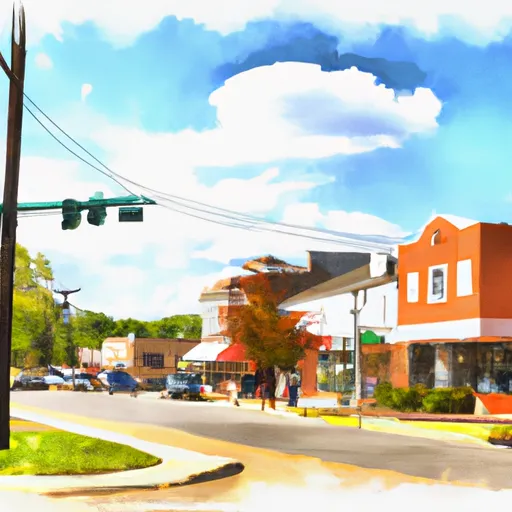-
 Snoflo Premium
Snoflo Premium
Get unlimited access to all our content
With no Ad interruptions! - Start Your Free Trial Login with existing account
Marriottsville
Eden Index
Climate
9.7
•
Recreation
2.8
•
Community
7.2
•
Safeguard
6.6/10

Marriottsville is a small, unincorporated community located in Howard County, Maryland. It has a humid subtropical climate, characterized by hot summers and mild winters. Summers in Marriottsville are typically warm and humid, with temperatures ranging from the mid-80s to low 90s Fahrenheit. Winters are cool, with temperatures averaging in the low to mid-30s.
The community lies near the Patapsco River, which contributes to the area's hydrology. The river provides opportunities for recreational activities such as fishing, kayaking, and canoeing. Additionally, the region is dotted with several lakes and ponds, offering further chances for water-based recreation.
In terms of outdoor activities, Marriottsville boasts several parks and recreational areas. The nearby Patapsco Valley State Park offers a range of activities, including hiking, biking, and horseback riding trails. The park's diverse landscapes, including wooded areas and cascading waterfalls, make it a popular destination for outdoor enthusiasts. Additionally, Marriottsville is surrounded by numerous golf courses, providing opportunities for golf lovers.
Overall, Marriottsville, Maryland, offers a pleasant climate, a variety of hydrological features, and several outdoor recreational opportunities, making it an attractive place for nature lovers and outdoor enthusiasts.
What is the Eden Index?
The Snoflo Eden Index serves as a comprehensive rating system for regions, evaluating their desirability through a holistic assessment of climate health, outdoor recreation opportunities, and natural disaster risk, acknowledging the profound impact of these factors on livability and well-being.
Climate Health Indicator (CHI): 9.7
Marriottsville receives approximately
1174mm of rain per year,
with humidity levels near 77%
and air temperatures averaging around
13°C.
Marriottsville has a plant hardyness factor of
6, meaning
plants and agriculture in this region thrive during a short period during spring and early summer. Most
plants will die off during the colder winter months.
By considering the ideal temperature range, reliable water supplies, clean air, and stable seasonal rain or snowpacks, the Climate Health Indicator (CHI) underscores the significance of a healthy climate as the foundation for quality living.
A healthy climate is paramount for ensuring a high quality of life and livability in a region, fostering both physical well-being and environmental harmony. This can be characterized by ideal temperatures, reliable access to water supplies, clean air, and consistent seasonal rain or snowpacks.
Weather Forecast
Streamflow Conditions
Upper Chesapeake
Area Rivers
Upper Chesapeake
Snowpack Depths
Upper Chesapeake
Reservoir Storage Capacity
Upper Chesapeake
Groundwater Levels
Recreational Opportunity Index (ROI): 2.8
The Recreational Opportunity Index (ROI) recognizes the value of outdoor recreational options, such as parks, hiking trails, camping sites, and fishing spots, while acknowledging that climate plays a pivotal role in ensuring the comfort and consistency of these experiences.
Access to outdoor recreational opportunities, encompassing activities such as parks, hiking, camping, and fishing, is crucial for overall well-being, and the climate plays a pivotal role in enabling and enhancing these experiences, ensuring that individuals can engage in nature-based activities comfortably and consistently.
Camping Areas
| Campground | Campsites | Reservations | Toilets | Showers | Elevation |
|---|---|---|---|---|---|
| Andrews AFB Military | None | 269 ft | |||
| Louise F. Cosca Regional Park | 23 | 223 ft | |||
| Cedarville State Forest | 27 | 198 ft | |||
| Greenbelt Park | 175 | 121 ft |
Nearby Ski Areas
Catastrophe Safeguard Index (CSI):
The Catastrophe Safeguard Index (CSI) recognizes that natural disaster risk, encompassing floods, fires, hurricanes, and tornadoes, can drastically affect safety and the overall appeal of an area.
The level of natural disaster risk in a region significantly affects safety and the overall livability, with climate change amplifying these risks by potentially increasing the frequency and intensity of events like floods, fires, hurricanes, and tornadoes, thereby posing substantial challenges to community resilience and well-being.
Community Resilience Indicator (CRI): 7.2
The Community Resilience Indicator (CRI) recognizes that education, healthcare, and socioeconomics are crucial to the well-being of a region. The CRI acknowledges the profound impact of these elements on residents' overall quality of life. By evaluating educational resources, healthcare accessibility, and economic inclusivity, the index captures the essential aspects that contribute to a thriving community, fostering resident satisfaction, equity, and social cohesion.

